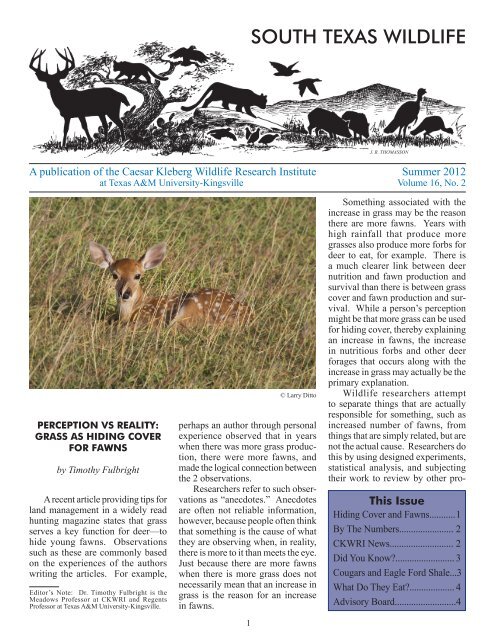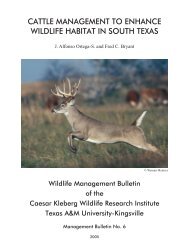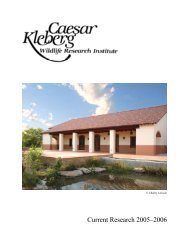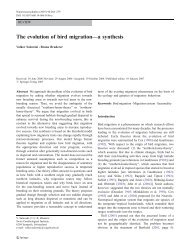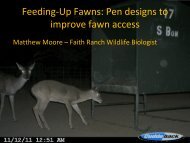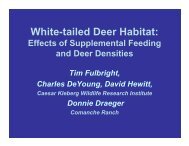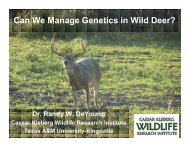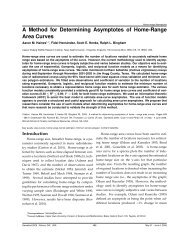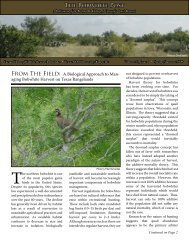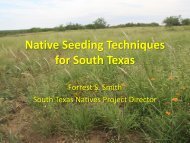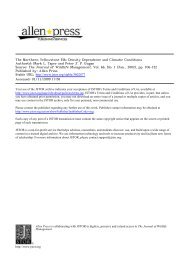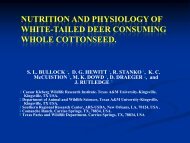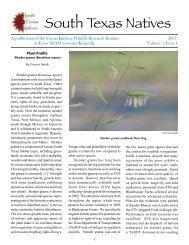south texas wildlife - Caesar Kleberg Wildlife Research Institute ...
south texas wildlife - Caesar Kleberg Wildlife Research Institute ...
south texas wildlife - Caesar Kleberg Wildlife Research Institute ...
You also want an ePaper? Increase the reach of your titles
YUMPU automatically turns print PDFs into web optimized ePapers that Google loves.
SOUTH TEXAS WILDLIFE<br />
J. R. THOMASSON<br />
A publication of the <strong>Caesar</strong> <strong>Kleberg</strong> <strong>Wildlife</strong> <strong>Research</strong> <strong>Institute</strong> Summer 2012<br />
at Texas A&M University-Kingsville Volume 16, No. 2<br />
PERCEPTION VS REALITY:<br />
GRASS AS HIDING COVER<br />
FOR FAWNS<br />
by Timothy Fulbright<br />
A recent article providing tips for<br />
land management in a widely read<br />
hunting magazine states that grass<br />
serves a key function for deer—to<br />
hide young fawns. Observations<br />
such as these are commonly based<br />
on the experiences of the authors<br />
writing the articles. For example,<br />
Editor’s Note: Dr. Timothy Fulbright is the<br />
Meadows Professor at CKWRI and Regents<br />
Professor at Texas A&M University-Kingsville.<br />
perhaps an author through personal<br />
experience observed that in years<br />
when there was more grass production,<br />
there were more fawns, and<br />
made the logical connection between<br />
the 2 observations.<br />
<strong>Research</strong>ers refer to such observations<br />
as “anecdotes.” Anecdotes<br />
are often not reliable information,<br />
however, because people often think<br />
that something is the cause of what<br />
they are observing when, in reality,<br />
there is more to it than meets the eye.<br />
Just because there are more fawns<br />
when there is more grass does not<br />
necessarily mean that an increase in<br />
grass is the reason for an increase<br />
in fawns.<br />
1<br />
© Larry Ditto<br />
Something associated with the<br />
increase in grass may be the reason<br />
there are more fawns. Years with<br />
high rainfall that produce more<br />
grasses also produce more forbs for<br />
deer to eat, for example. There is<br />
a much clearer link between deer<br />
nutrition and fawn production and<br />
survival than there is between grass<br />
cover and fawn production and survival.<br />
While a person’s perception<br />
might be that more grass can be used<br />
for hiding cover, thereby explaining<br />
an increase in fawns, the increase<br />
in nutritious forbs and other deer<br />
forages that occurs along with the<br />
increase in grass may actually be the<br />
primary explanation.<br />
<strong>Wildlife</strong> researchers attempt<br />
to separate things that are actually<br />
responsible for something, such as<br />
increased number of fawns, from<br />
things that are simply related, but are<br />
not the actual cause. <strong>Research</strong>ers do<br />
this by using designed experiments,<br />
statistical analysis, and subjecting<br />
their work to review by other pro-<br />
This Issue<br />
Hiding Cover and Fawns........... 1<br />
By The Numbers....................... 2<br />
CKWRI News........................... 2<br />
Did You Know......................... 3<br />
Cougars and Eagle Ford Shale... 3<br />
What Do They Eat................... 4<br />
Advisory Board..........................4
By The Numbers<br />
4 number of toes on the front foot of a nine-banded armadillo<br />
(A Field Guide to Mammals of North America North of Mexico, F.A. Reid)<br />
40–60 incubation period in number of days for eggs of the Texas<br />
banded gecko (Field Guide to Texas Reptiles and Amphibians, R.D. Bartlett and<br />
P.P. Bartlett)<br />
484 estimated number in millions of dollars spent by deer<br />
hunters to access private lands in 2006 (USFWS)<br />
© Timothy Fulbright<br />
White-tailed deer fawns in South Texas<br />
select bed sites with thick grass cover<br />
that often includes a shrub.<br />
fessionals. As a result, the scientific<br />
literature is a more reliable source<br />
of information to base management<br />
decisions than articles found in nontechnical<br />
magazines.<br />
I recently read a dozen articles in<br />
scientific journals published between<br />
1979 and 2011 by researchers examining<br />
where white-tailed deer fawns<br />
chose to bed down. These studies<br />
were conducted in a variety of locations<br />
ranging from the grasslands of<br />
North Dakota to the forests of Michigan<br />
and to the brushlands of South<br />
Texas. One thing that the results<br />
of all these studies had in common<br />
is that fawns usually bed down in<br />
places with thick cover. The type of<br />
plants that compose the cover where<br />
fawns bed down is not as important<br />
as is the thickness of the vegetation.<br />
In grasslands, fawns often bed down<br />
in dense, tall grasses and forbs; in<br />
savannahs and shrublands, they<br />
often bed down beside shrubs.<br />
<strong>Wildlife</strong> managers reading magazines<br />
that talk about the importance<br />
of grass for fawning cover might get<br />
the idea that clearing woody vegetation<br />
and planting grasses are good<br />
management practices for whitetailed<br />
deer. In most of the range<br />
of white-tailed deer, management<br />
practices such as these can harm<br />
rather than benefit deer.<br />
In addition, the relative importance<br />
of “fawning cover” to help<br />
fawns avoid being seen by predators<br />
is questionable. No research to date<br />
has shown that more cover results in<br />
fewer fawns being seen and eaten by<br />
predators. Coyotes, for example,<br />
hunt their prey by hearing and smell<br />
as well as sight. One thing fawns<br />
may do when they are looking for<br />
a place to bed down is to find areas<br />
where it is harder for predators to<br />
smell them.<br />
Several deer researchers have<br />
suggested than fawning cover is<br />
more important for shade than it is<br />
for predator avoidance. Bedding<br />
down in the shade under a bush<br />
during midday in July to avoid<br />
excessive heat loads definitely<br />
makes sense.<br />
The bottom line is this: be<br />
careful about basing management<br />
decisions on people’s perceptions.<br />
Management decisions are best<br />
made if they are supported by<br />
research that has been subjected to<br />
rigorous peer review—then your<br />
<strong>wildlife</strong> management decisions will<br />
more likely be based on reality. ~<br />
CKWRI NEWS<br />
Karen Hixon Honored*<br />
Karen Hixon, spouse of<br />
CKWRI’s advisory board member<br />
Tim Hixon, was recognized for her<br />
lifetime of service to <strong>wildlife</strong> conservation<br />
by the Rotary Club of Corpus<br />
Christi and was presented with the<br />
Harvey Weil Sportsman Conservationist<br />
of the Year Award during a<br />
dinner on Saturday, April 28, 2012,<br />
at the Rob and Bessie Welder <strong>Wildlife</strong><br />
Foundation in Sinton, Texas.<br />
Harvey Weil was a longtime<br />
South Texas sportsman, attorney,<br />
conservationist, and Rotarian who<br />
dedicated his life to the preservation<br />
of nature and sportsmanship. To<br />
perpetuate Harvey’s legacy, a distinguished<br />
individual is chosen annually<br />
by the Rotary Club of Corpus<br />
Christi for this prestigious award.<br />
Karen’s background includes<br />
being appointed to the Texas Parks<br />
and <strong>Wildlife</strong> Commission in 2007,<br />
and she continues to serve in that<br />
role today. She also serves on the<br />
Board of Trustees of the Peregrine<br />
Fund, on the Texas Advisory Board<br />
for Trust for Public Land, and on the<br />
Advisory Board for Mitchell Lake<br />
Audubon Center in San Antonio,<br />
Texas. In addition, Karen has served<br />
on the Texas Parks and <strong>Wildlife</strong><br />
Foundation and on the Board of the<br />
Texas Nature Conservancy.<br />
Karen Hixon being presented with the<br />
Harvey Weil Sportsman Conservationist<br />
of the Year Award by Richard Leshin<br />
(left) and Mo Moorhead, sponsored by<br />
the Rotary Club of Corpus Christi.<br />
* Material from a press release by Lysa Chapman,<br />
Rotary Club of Corpus Christi.<br />
2
CKWRI congratulates Karen for<br />
her conservation service and welldeserved<br />
recognition by the Rotary<br />
Club of Corpus Christi. ~<br />
EAGLE FORD SHALE AND<br />
COUGAR POPULATIONS<br />
by Michael Tewes<br />
Former CKWRI Grad Student<br />
Receives Promotion<br />
One of CKWRI’s former<br />
graduate students Jennifer Mock<br />
Schaeffer was recently promoted<br />
to Government Affairs Director by<br />
the Association of Fish and <strong>Wildlife</strong><br />
Agencies (AFWA). Schaeffer will<br />
oversee and direct the legislative<br />
work of AFWA before the U.S. Congress,<br />
and the public policy work of<br />
AFWA before the federal Executive<br />
Branch agencies.<br />
Since joining AFWA in May<br />
2002, Jennifer has served as the<br />
Multistate Conservation Grant Program<br />
Coordinator<br />
and<br />
most recently<br />
as AFWA’s<br />
Agriculture<br />
Conservation<br />
Policy Analyst<br />
(Farm<br />
© Laura MacLean<br />
Jennifer Mock Schaeffer,<br />
former graduate<br />
student of CKWRI at<br />
TAMUK, was recently<br />
promoted to Government<br />
Affairs Director<br />
by the Association<br />
of Fish and <strong>Wildlife</strong><br />
Agencies.<br />
Bill). She also<br />
has provided<br />
staff support<br />
for AFWA’s<br />
Agricultural<br />
Conservation<br />
Committee<br />
and its<br />
11 working<br />
groups.<br />
Jennifer received a Bachelor of<br />
Science degree in Agriculture with<br />
a major in Range and <strong>Wildlife</strong> Management<br />
and a minor in Biology at<br />
Texas A&M University-Kingsville.<br />
She also received her Master of<br />
Science degree at Texas A&M<br />
University-Kingsville in Range and<br />
<strong>Wildlife</strong> Management, working with<br />
Dr. Michael Tewes on wild cats. ~<br />
Consider giving a tax-deductible<br />
donation to CKWRI<br />
How will cougars fare in South<br />
Texas Breeding populations of<br />
cougars presently occur in South<br />
Texas and the Trans-Pecos region<br />
of western Texas. Previous research<br />
has suggested that the South Texas<br />
cougar population is relatively small<br />
and isolated.<br />
The Eagle Ford Shale development<br />
involves an increase in human<br />
activity affecting areas that previously<br />
were relatively undisturbed.<br />
Because the shale play overlaps<br />
some of the best cougar habitat in<br />
South Texas, this development may<br />
impact this wild cat.<br />
The basis for this emerges from<br />
our research at the CKWRI in which<br />
we identified possible vulnerability<br />
of the South Texas cougar population.<br />
Small populations are often<br />
subjected to threats that are more<br />
easily absorbed by larger populations.<br />
Also, inbreeding is more<br />
likely in small populations.<br />
Our graduate student, Joe<br />
Holbrook, found low levels of<br />
genetic diversity in cougar samples<br />
from South Texas. During the past<br />
50 years in South Texas, genetic<br />
diversity has dropped by 9% and<br />
the “effective population size” of<br />
cougars has declined by 50%. The<br />
West Texas population has remained<br />
stable and is part of a larger population<br />
with habitat that extends into<br />
Mexico, New Mexico, and the<br />
Editor’s Note: Dr. Michael Tewes holds The Frank<br />
Daniel Yturria Endowed Chair for Wild Cat Studies<br />
at CKWRI and is a Regents Professor at Texas<br />
A&M University-Kingsville.<br />
Courtesy of Texas Parks and <strong>Wildlife</strong><br />
Rocky Mountains. Our genetic findings<br />
have confirmed that dispersal<br />
can occur periodically into and<br />
out of the South Texas population.<br />
However, the low number of successful<br />
dispersers may be too few to<br />
maintain genetic diversity.<br />
Another study that we have completed<br />
was led by Dr. John Young<br />
who used population modeling to<br />
assess the survival chances of the<br />
small cougar population in South<br />
Texas. Results suggested potential<br />
threats for cougar survival in this<br />
region. Variation in population<br />
reproduction, survival, and habitat<br />
conditions, including drought, which<br />
is frequent, could threaten cougar<br />
survival in South Texas.<br />
Our additional research at the<br />
CKWRI used an ecological niche<br />
computer model that showed most<br />
of the likely habitat for cougars in<br />
South Texas occurs in the western<br />
portion of the region. This habitat<br />
is not wide-spread or extensive, but<br />
generally localized, which is another<br />
reason for concern.<br />
Much of this habitat coincides<br />
with the historic and current assessments<br />
of cougar distribution and a<br />
belief that a population core occurs<br />
in the west-central area of South<br />
Did You Know<br />
The red-winged blackbird has a polygynous mating strategy (1 male<br />
to several females). (Handbook of Birds of the World, Volume 16)<br />
Ord’s kangaroo rats are considered nocturnal and are most active<br />
on dark, cloudy nights. (A Field Guide to Mammals of North America North of Mexico,<br />
F.A. Reid)<br />
3
Texas. These research findings on<br />
cougars in South Texas are coinciding<br />
with the unfolding development<br />
of the Eagle Ford Shale. The Eagle<br />
Ford Shale is a recently discovered<br />
hydrocarbon formation of significant<br />
importance because of its capability<br />
of producing more gas and oil than<br />
other shale deposits.<br />
Development of the Eagle Ford<br />
Shale represents a major transformation<br />
of the economic and rural<br />
environment in many parts of South<br />
Texas, where production from the<br />
vast oil and gas field has surpassed<br />
forecasts. In the past 2 years, there<br />
has been a sharp increase in the infrastructure<br />
and extraction activities<br />
associated with this petrochemical<br />
resource. The number of drilling<br />
permits for the Eagle Ford Shale<br />
increased from 33 in 2008 to 1,229<br />
in 2010.<br />
Actual development continues<br />
to exceed the predictions of rapid<br />
growth. The Eagle Ford Consortium<br />
estimated that the shale would<br />
produce 2.1 million barrels of oil in<br />
2010. Instead, the shale produced<br />
What Do They Eat<br />
Advisory Board<br />
The Advisory Board of the <strong>Caesar</strong> <strong>Kleberg</strong> <strong>Wildlife</strong> <strong>Research</strong> <strong>Institute</strong> provides<br />
leadership in all aspects of our work. We are indebted to them for their commitment<br />
to CKWRI and its mission.<br />
Gus T. Canales<br />
T. Dan Friedkin<br />
Henry R. Hamman<br />
(Chairman)<br />
George C. “Tim” Hixon<br />
Karen Hunke<br />
4.4 million in the first 11 months of<br />
that year. For 2011, production of<br />
8.7 million barrels of oil was forecasted.<br />
Almost 22 million barrels<br />
of oil were extracted in the January-<br />
November period of 2011. A prediction<br />
was not given for 2012.<br />
<strong>Wildlife</strong> biologists visiting the<br />
area where the Eagle Ford Shale<br />
overlaps the core of the cougar<br />
population are amazed at the rapid<br />
oil and gas development within the<br />
area. There is a major increase in<br />
the number of wells and related<br />
roads and pipelines. Truck traffic<br />
has greatly increased on many of<br />
these rural roads, and activities on<br />
previously undisturbed ranches have<br />
expanded tremendously.<br />
Northern cardinals forage on seeds, fruits, insects, and snails.<br />
(Handbook of Birds of the World, Volume 16)<br />
A. C. Jones, IV<br />
David Winfield Killam<br />
Tio <strong>Kleberg</strong><br />
C. Berdon Lawrence<br />
Kenneth E. Leonard<br />
James A. McAllen<br />
Barry Coates Roberts<br />
Stuart W. Stedman<br />
Buddy Temple<br />
Ben F. Vaughan, III<br />
Bryan Wagner<br />
Charles A. Williams<br />
Some industry observers suggest<br />
this development may continue for<br />
15 to 20 years. This activity will be<br />
a major economic engine for many<br />
counties in South Texas, benefitting<br />
numerous small communities and<br />
extensive rural areas. However,<br />
the concern for cougars is that the<br />
western portion of the Eagle Ford<br />
Shale overlaps much of the historical<br />
and current core area of cougars in<br />
South Texas.<br />
In summary, the exploration in<br />
the Eagle Ford Shale likely poses<br />
additional risk to the vulnerable<br />
cougar population in South Texas—<br />
a risk that needs to be measured.<br />
There is an urgent need for information<br />
to assess the status of cougars<br />
in South Texas, as well as cougar<br />
responses to the Eagle Ford Shale<br />
development. ~<br />
Franklin’s ground squirrels have an omnivorous diet consisting of<br />
seeds, plant material, small mammals, toads, birds, and insects.<br />
(A Field Guide to Mammals of North America North of Mexico, F.A. Reid)<br />
Visit our web page at<br />
http://www.ckwri.tamuk.edu<br />
<strong>Caesar</strong> <strong>Kleberg</strong> <strong>Wildlife</strong><br />
<strong>Research</strong> <strong>Institute</strong><br />
700 University Boulevard<br />
MSC 218<br />
Kingsville, Texas 78363-8202<br />
Editor: Alan Fedynich, Ph.D.<br />
SOUTH TEXAS WILDLIFE is printed on recycled paper<br />
4


